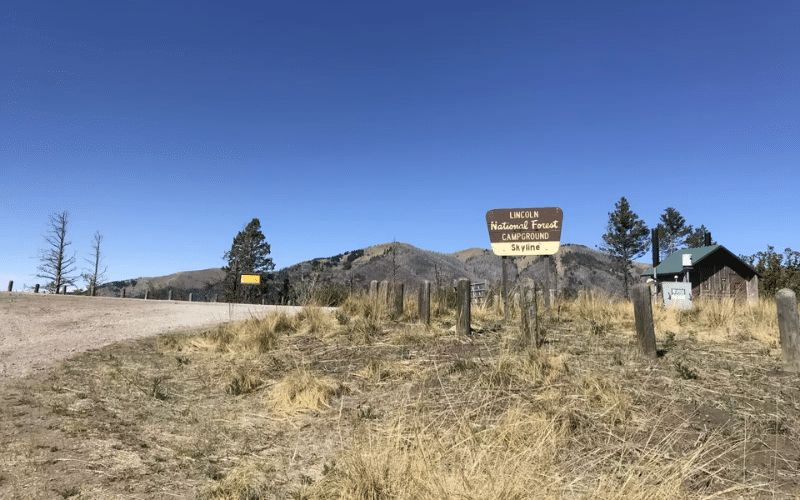Discover diverse animals in Lincoln National Forest: from Cougars, Mule Deer and Bobcats to Wild Horses. Unveil their habitats and top spots on our hikes!
Get ready to embark on a wild journey through Lincoln National Forest! Nestled in New Mexico, this forest is a hidden gem for animal enthusiasts.
Whether you’re a budding biologist or simply an adventurer with a love for nature, you’re in for a treat. We’ve roamed its trails, climbed its peaks, and wandered its valleys to bring you a list of 15 amazing animals you can spot here.
From the majestic Rocky Mountain Elk to the elusive Mexican Spotted Owl, every creature tells a unique tale of the forest.
Dive in and discover the incredible biodiversity that awaits in the heart of the American Southwest! So, grab your binoculars, lace up those hiking boots, and let’s meet the residents of Lincoln National Forest!
Rocky Mountain Elk
The Rocky Mountain Elk stands as a testament to the majestic beauty and grandeur of the Lincoln National Forest. With a statuesque build and a dense coat ranging from tan to dark brown, this elk commands attention.
The males, especially, are renowned for their impressive antlers, which they shed and regrow annually, reaching their peak size in the fall.
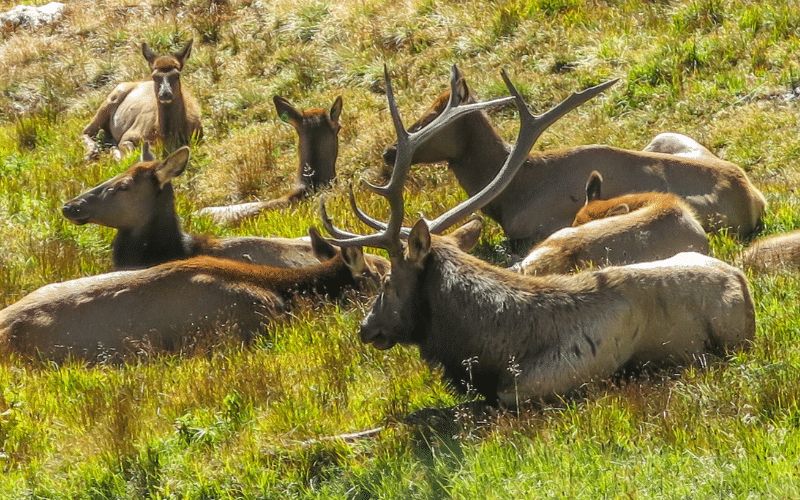
Within the Lincoln National Forest, the Smokey Bear Ranger District and the White Mountain Wilderness Area are prime territories for these elks.
Wander through these regions, and you may find herds grazing in meadows or hear their signature bugling calls echoing through the valleys, especially during mating seasons.
These calls, a combination of deep resonant tones and higher pitches, become a melodious anthem of the wild, enriching the forest experience.
An interesting aspect of the Rocky Mountain Elk is their ability to communicate through bugling. This vocalization, beyond being a mating call, can signal alarm, assert dominance, or coordinate movements within a herd.
Witnessing these elks, with their distinctive calls and graceful presence, adds depth to any adventure in the Lincoln National Forest, embodying the wild spirit and rich biodiversity of the region.
Mule Deer
The Mule Deer, with its signature oversized ears and graceful strides, is a cherished sight within the Lincoln National Forest.
These deer exhibit a poised elegance, their sleek, tawny coats allowing them to seamlessly blend into the forested backdrop.
Their namesake “mule-like” ears, always alert and rotating, serve as nature’s radar, keenly picking up the faintest rustles of the underbrush.
In the vast expanse of Lincoln National Forest, the Capitan Mountains emerge as a favorite haven for these deer.
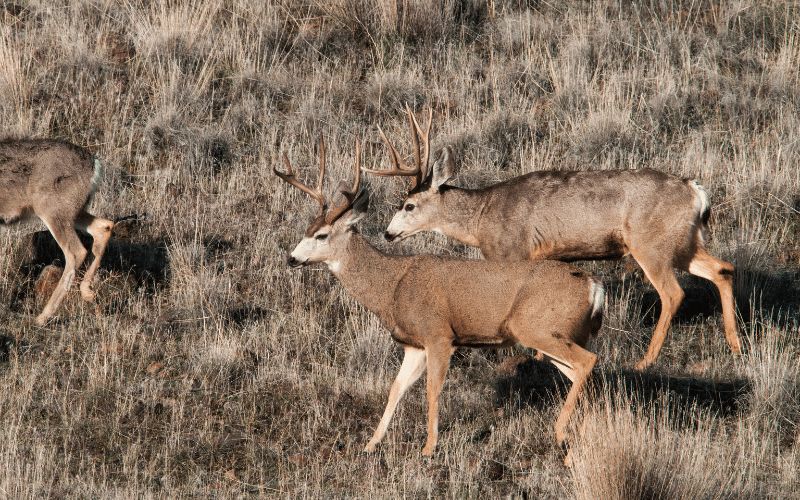
Particularly around dawn or dusk, the gentle sloping terrains and the woodland fringes of these mountains come alive with the sight of Mule Deer foraging or leisurely grazing.
Their cautious demeanor and bursts of swift motion offer a captivating watch for any nature enthusiast.
Beyond their visual appeal, the Mule Deer carries a fun piece of trivia: their name is a direct nod to their large ears, reminiscent of those of a mule.
These ears are not just for show; they play a crucial role in the deer’s keen sense of hearing, enabling them to detect potential threats from a distance.
A stroll through the trails of the Capitan Mountains offers the delightful possibility of an encounter with this quintessential resident of the Lincoln National Forest.
Aoudad (Barbary Sheep)
The Aoudad, also referred to as the Barbary Sheep, introduces an exotic touch to the fauna of the Lincoln National Forest.
Originating from North Africa’s rocky regions, these sheep display a muscular frame with a unique double-layered coat, helping them navigate both the hot and cold climates.
Their horns, which sweep back in both males and females, provide a distinctive silhouette against the backdrop of the forest.
Within the confines of Lincoln National Forest, the Aoudad has found solace in the rugged terrains of the Sacramento Mountains.
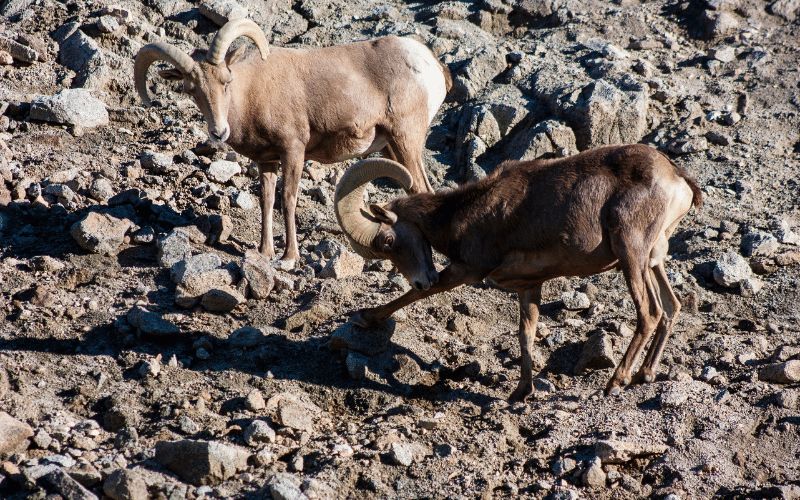
The craggy landscapes and sparse vegetation mimic their native habitats, offering both challenges and sustenance.
Hikers and wildlife enthusiasts keen on spotting these creatures might have the best luck in these higher altitudes, where the Aoudad roams free, leaping across boulders with an agility that belies their size.
What makes the Aoudad’s presence in New Mexico even more fascinating is their transcontinental journey.
Originally introduced as game animals, these sheep have since established a wild population, blending the essence of North African landscapes with the charm of the American Southwest.
Their adaptability and survival instincts in a foreign land make the Aoudad an emblem of nature’s persistent resilience within the Lincoln National Forest.
American Black Bear
The American Black Bear, with its imposing stature and shaggy coat, stands out as a mesmerizing sight in the Lincoln National Forest.
These bears, typically draped in glossy black, can sometimes surprise with shades of brown or cinnamon. Their expressive eyes and robust build are characteristic of a species perfectly adapted to forest life.
Within the vast expanse of Lincoln National Forest, certain sections are particularly favored by these bears. The dense woods of the Smokey Bear Ranger District offer shelter and abundant food, making it a popular haunt.
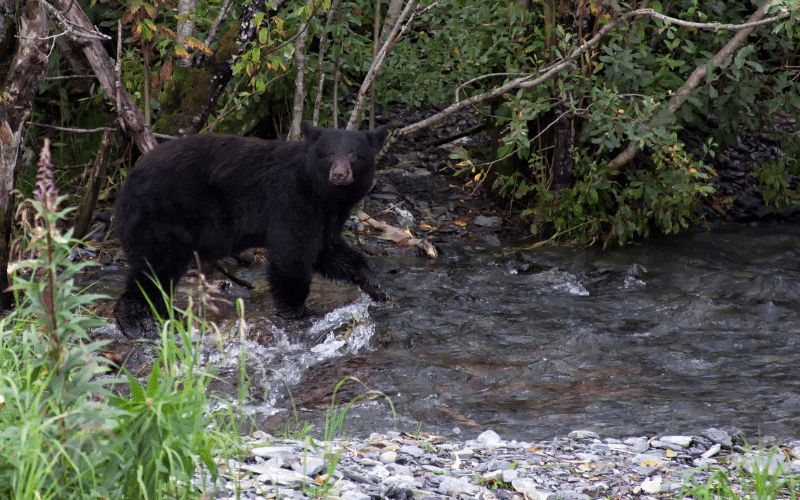
Meanwhile, the remote terrains of the Sacramento Mountains provide the solitude and vast wilderness areas these creatures often seek.
While they naturally prefer berries, nuts, and small critters, their curious nature occasionally leads them to investigate campgrounds, lured by the aroma of human food.
Such adaptability is a testament to their intelligence and survival instincts.
For visitors to the Lincoln National Forest, the presence of the American Black Bear serves as a reminder of the rich, wild heritage the forest preserves and the need for respect and safety during encounters.
Wild Turkey
The Wild Turkey is an unexpectedly charismatic presence in the Lincoln National Forest. Proud and striking, these birds are not the domesticated turkeys many might be familiar with.
Instead, they sport a gleaming array of feathers, from rich browns to iridescent shades, and an upright posture that adds to their commanding presence.
In the Lincoln National Forest, Wild Turkeys are commonly spotted in areas where the woodlands meet open meadows, providing them with a mix of shelter and feeding grounds.
The Guadalupe Ranger District, with its blend of dense woods and clearings, is a particularly favored habitat for these birds.
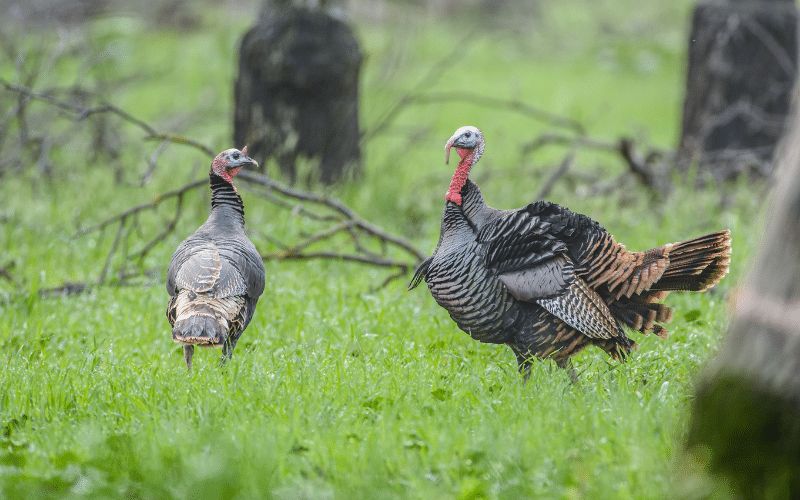
They can often be seen foraging on the forest floor in the early morning or late afternoon, pecking at seeds, berries, and small insects.
They often move in groups, known as flocks, and their vocalizations — from clucks to distinctive gobbles — resonate through the forest, providing an unmistakable audio backdrop.
Observing a flock of Wild Turkeys moving gracefully through the Lincoln National Forest, with their plumage shimmering in the dappled sunlight, is a treat for both casual visitors and avid birdwatchers alike.
Mexican Spotted Owl
The Mexican Spotted Owl is one of the captivating avian residents of the Lincoln National Forest. With dark brown plumage peppered with white spots and a pale face framed by darker rings, this owl exudes an aura of mystique.
Its large, soulful eyes have a depth that seems to hold the secrets of the forest nights, making any sighting of this bird an enchanting experience.
Within the Lincoln National Forest, the Mexican Spotted Owl favors the old-growth forests and steep-walled canyons, where the dense canopy and rugged terrains provide the seclusion it seeks.
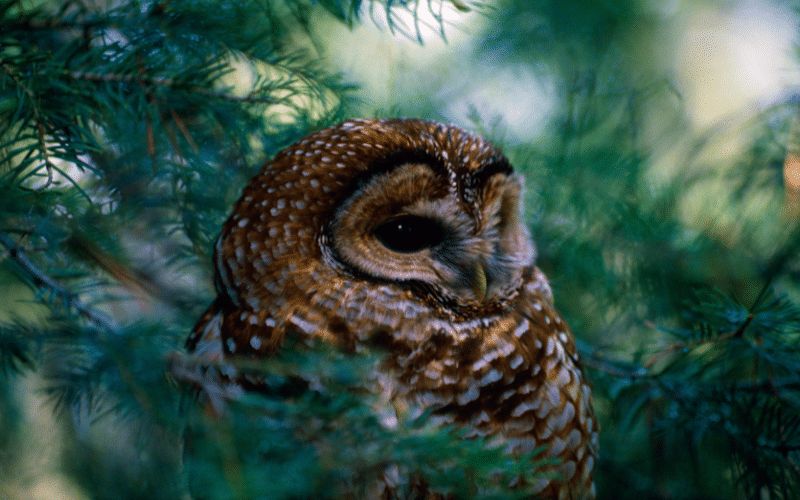
These habitats offer both shelter from predators and a rich hunting ground, where the owl silently swoops down to catch its prey under the cloak of darkness.
What makes the Mexican Spotted Owl particularly interesting is its status as a threatened species. Conservation efforts are in place to protect and monitor these birds, ensuring their continued presence in the forest.
This owl’s preference for mature forests underscores the importance of preserving natural habitats and maintaining the rich tapestry of the forest ecosystem.
For birdwatchers and nature enthusiasts exploring the depths of the Lincoln National Forest, the hoots and fleeting shadows of the Mexican Spotted Owl become a cherished memory, a symbol of the forest’s depth and diversity.
New Mexico Meadow Jumping Mouse
The New Mexico Meadow Jumping Mouse is a small yet noteworthy inhabitant of the Lincoln National Forest.
This diminutive rodent, with its soft brownish-gray fur and white underbelly, might be easy to overlook, but its unique characteristics make it stand out.
Its elongated hind legs enable it to make impressive leaps, often several times its body length, lending it its “jumping” descriptor.
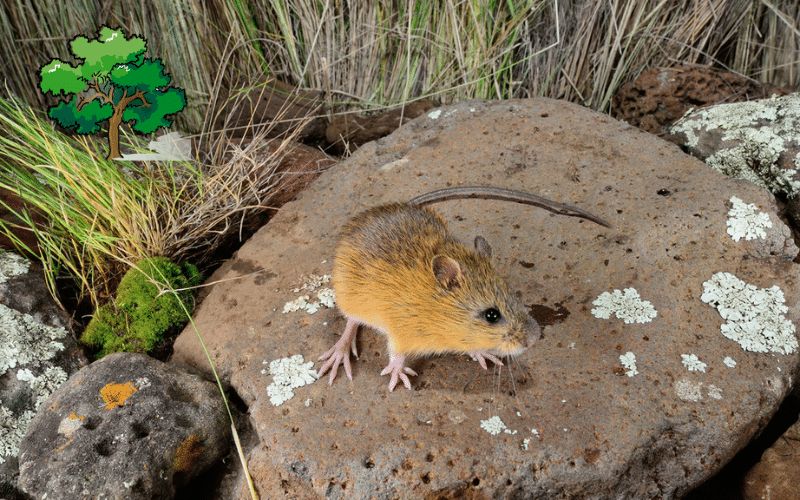
In the Lincoln National Forest, this jumping mouse predominantly thrives in areas rich with wet meadows and riparian habitats. The lush banks of streams and rivers, replete with tall grasses and sedges, are ideal spots for these mice to forage and nest.
If you’re strolling along the water’s edge, particularly in the evening or early dawn, you might catch a fleeting glimpse of this mouse darting through the grass or making its characteristic jumps.
A fascinating fact about the New Mexico Meadow Jumping Mouse is its hibernation pattern. It can hibernate for up to nine months of the year, relying on the fat reserves it accumulates during its active months.
This extended hibernation is essential for its survival, given the short availability of its preferred foods.
A trek through the wet meadows of the Lincoln National Forest offers a chance to appreciate not just the grand fauna but also the smaller, equally captivating species like this unique mouse.
Checkerspot butterfly
The Checkerspot butterfly adds a dash of color and whimsy to the Lincoln National Forest’s vast expanse. With wings adorned in a mosaic of orange, black, and white patterns, this butterfly is a visual treat, fluttering from flower to flower in a delicate dance.
The intricate checkered design on its wings gives it its name, and it’s a delightful sight to observe as it basks in the sun or feeds on nectar.
Within the Lincoln National Forest, meadows replete with wildflowers are the prime habitats for the Checkerspot butterfly.
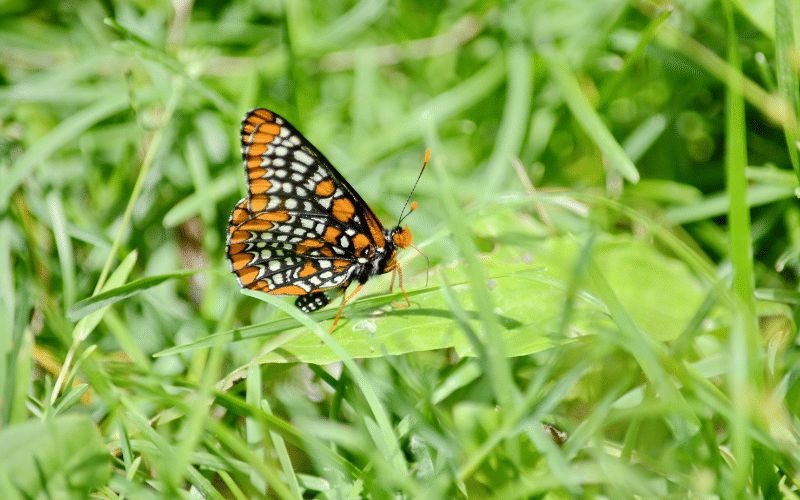
As the sun warms the earth, these butterflies can often be seen in clearings, hovering over blossoms, or resting with their wings spread, displaying their stunning patterns.
The forest’s edges and sunlit glades that harbor a range of native flowering plants are particularly attractive to these winged wonders.
An intriguing fact about the Checkerspot butterfly is its close relationship with specific host plants.
The larvae, or caterpillars, of this butterfly species often feed on particular plants, which influence their survival and growth. This symbiotic relationship emphasizes the significance of preserving diverse habitats within the forest.
For those wandering the trails of the Lincoln National Forest, the Checkerspot butterfly serves as a reminder of the delicate beauty and intricate connections that nature weaves in its tapestry.
Jackrabbits
Jackrabbits, with their long ears and powerful hind legs, are a lively presence in the Lincoln National Forest.
These creatures, despite their name, are not rabbits but hares, and their adaptability to various environments makes them a common sight across the diverse terrains of the forest.
Their sleek, agile bodies, often coated in a mix of gray and brown, allow them to dart through open spaces with impressive speed.
In the Lincoln National Forest, you’re likely to spot Jackrabbits in areas where grasslands meet the edges of woodlands.
These transitional zones offer them both the shelter of the trees and the open expanses they need to forage and make their characteristic leaps.
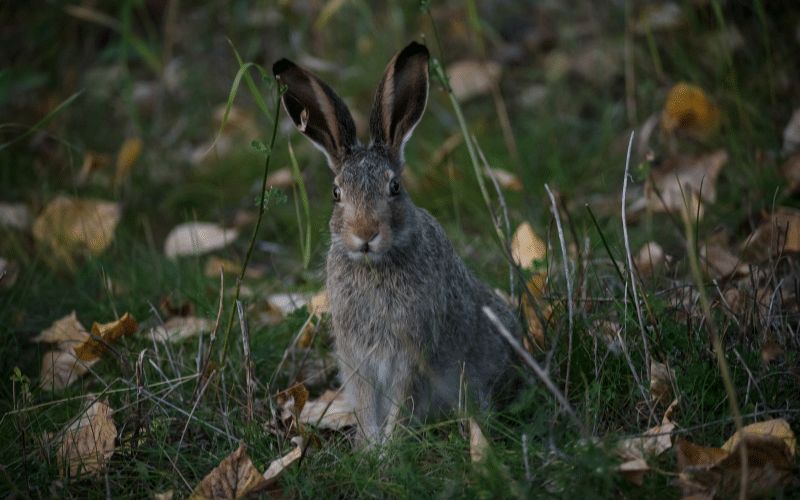
The early morning or late afternoon, when the forest bathes in a soft golden hue, is often when these hares are most active, bounding around in search of food or simply enjoying the play of shadows.
A fun tidbit about Jackrabbits is their adaptability in terms of diet. They can consume a variety of vegetation, from grasses to shrubs. Their oversized ears, besides being a notable visual trait, play a vital role in thermoregulation, helping them stay cool in warmer climates.
As you traverse the trails of Lincoln National Forest, keep an eye out for these spirited creatures, who add a touch of whimsy and wild agility to the landscape.
Red-tailed Hawk
The Red-tailed Hawk, with its broad wingspan and iconic rust-colored tail, is a majestic presence in the skies of the Lincoln National Forest.
Often seen soaring high above or perched with a keen eye on tall trees and telephone poles, this raptor is a symbol of the vast and open landscapes it surveys.
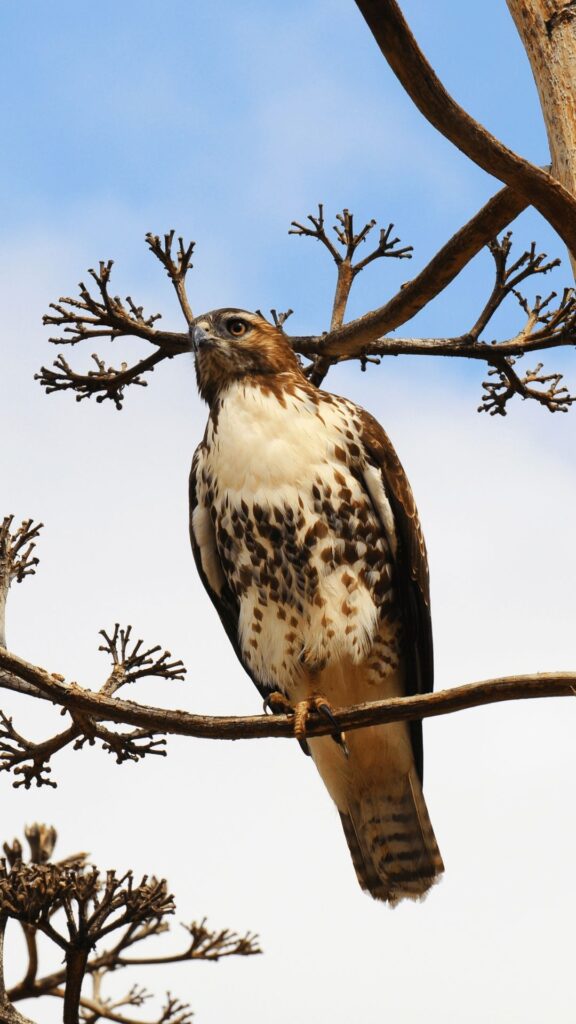
In the Lincoln National Forest, open woodlands and the edges of meadows are popular haunts for these hawks.
They seek vantage points to scout for prey, which ranges from small mammals to birds and reptiles. The forest’s open areas, interspersed with tall perching spots, offer the perfect habitat.
A thrilling moment for many visitors is the Red-tailed Hawk’s cry, a piercing and resonant sound that underscores the wild spirit of the forest. Their distinctive call, often used in movies, is an unmistakable sound of the American wilderness.
Mountain Bluebird
A jewel of the Lincoln National Forest, the Mountain Bluebird is a sight to behold with its vibrant blue plumage.
These birds, often seen flitting about in open areas, add a splash of color against the forest’s green backdrop.
Favored spots within the forest for these bluebirds include open meadows and areas affected by recent fires, where they can find plenty of insects to feed on.
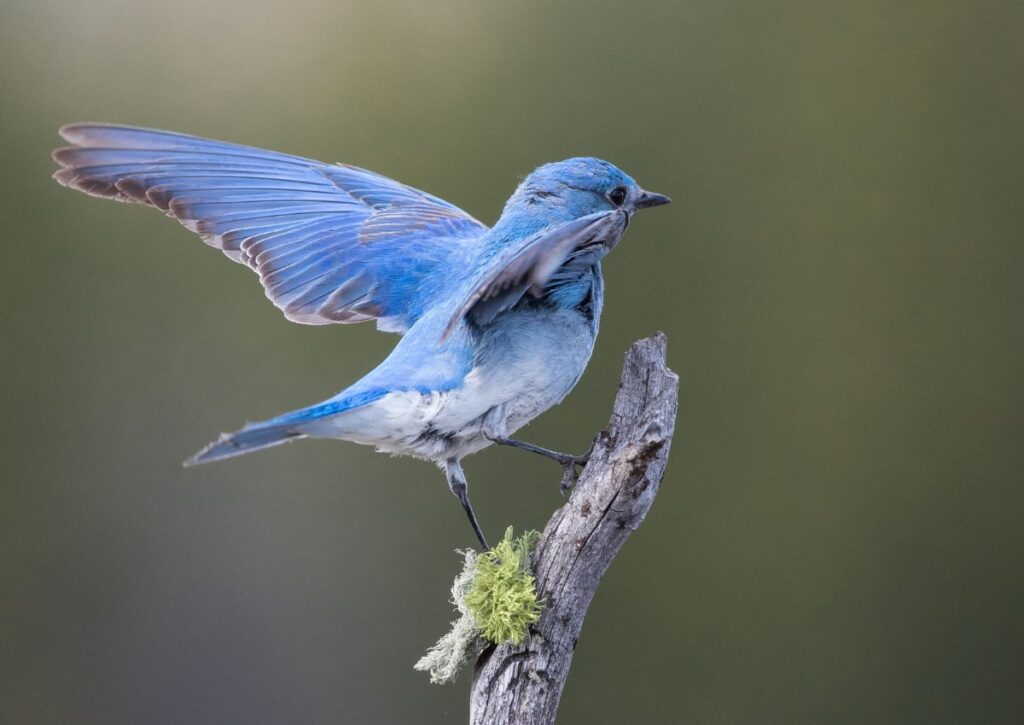
Their cheerful songs and agile flight patterns, often close to the ground, make them a joy to observe.
A lovely tidbit about the Mountain Bluebird is its habit of nesting in cavities.
Old woodpecker holes or natural tree hollows often serve as their homes, making the preservation of mature trees crucial for their survival.
Tarantulas
For those intrigued by the smaller wonders of the Lincoln National Forest, the presence of tarantulas might come as an exciting discovery. These large, hairy spiders, often misunderstood, are a fascinating part of the forest’s ecosystem.
You can find tarantulas in the forest’s drier and warmer areas, where they burrow into the ground and create their homes. These burrows serve as hiding spots, mating chambers, and hunting grounds.
A unique spectacle in the life of tarantulas is their annual migration, especially seen in males searching for mates.
During this period, hikers might encounter these spiders more frequently, as they traverse the forest floor.
While they might appear intimidating, tarantulas are generally not harmful to humans and serve as essential predators in controlling insect populations.
Cougar (Mountain Lion)
The cougar, or mountain lion, is a formidable creature that commands respect in the wild. Sporting a lean and muscular body covered in a smooth tawny coat, the mountain lion’s most distinguishing feature might be its piercing green or hazel eyes.
These majestic cats can weigh up to 200 pounds and have a range that spans from Canada to South America. In the Lincoln National Forest, cougars typically roam the more secluded and rugged terrains, often at higher elevations.
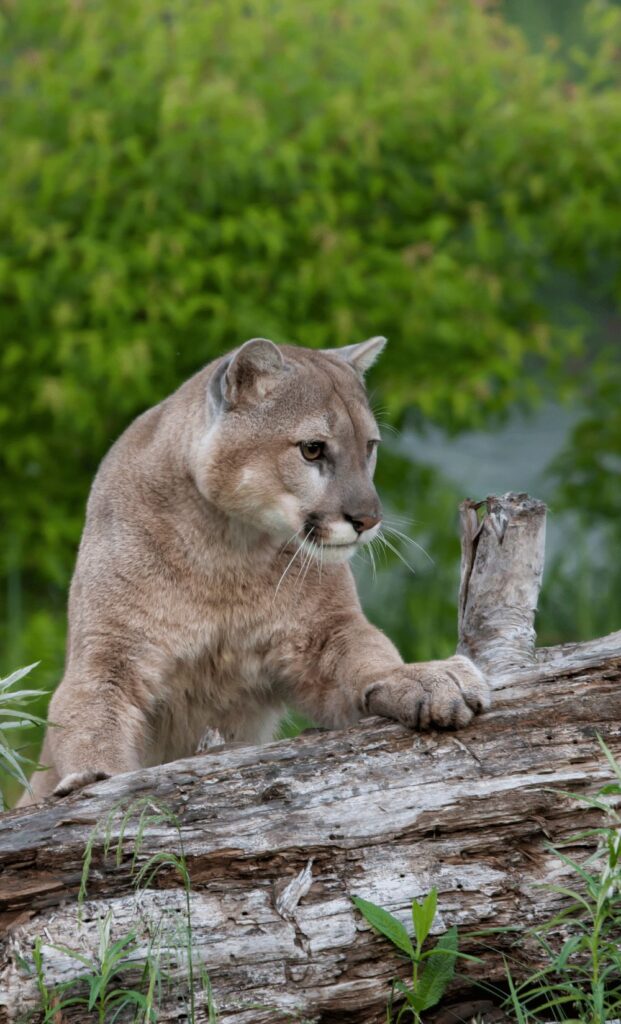
They’re master stalkers, primarily preying on deer. If you’re hiking in the forest, you’re more likely to come across their tracks than the animals themselves, given their elusive nature.
Interestingly, despite their size, cougars cannot roar. Instead, they communicate through purrs, growls, hisses, and chirps.
Bobcat
Distinct from the cougar but equally impressive is the bobcat. Its name derives from its noticeably short, ‘bobbed’ tail.
With a body size slightly larger than a domestic cat and marked with spotted patterns that serve as camouflage, bobcats are agile predators.
Within Lincoln National Forest, they’re most often found in woodland areas with dense underbrush, perfect for stalking prey like rabbits and birds.
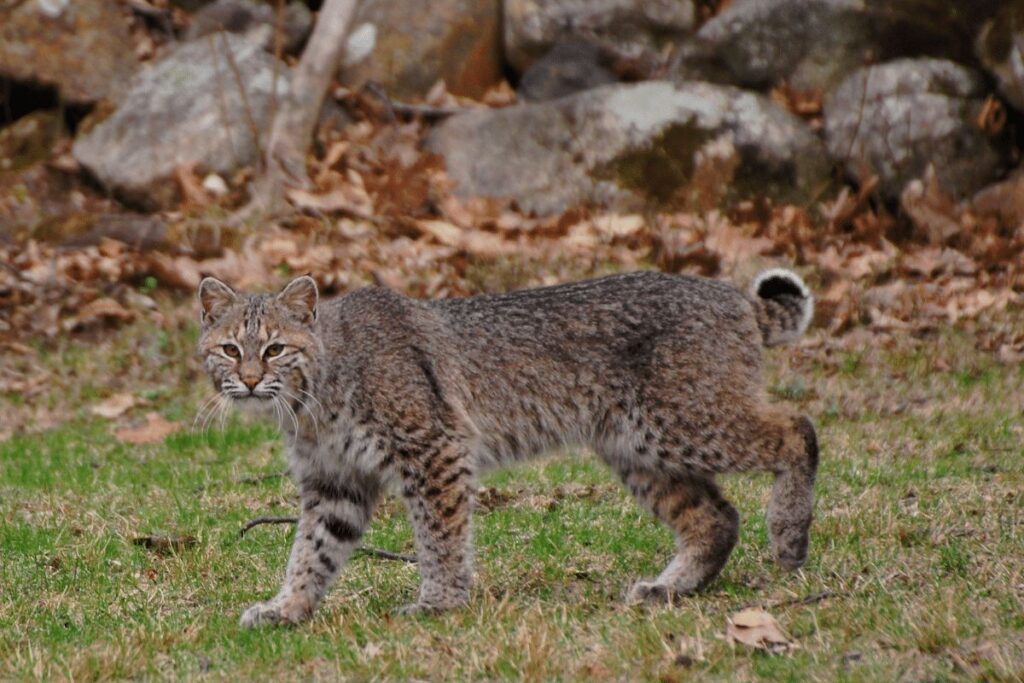
Their tufted ears and sharp eyes give them a wild appearance that belies their often secretive nature. One remarkable fact about bobcats is their adaptability.
In various environments, they’ve been known to swim while hunting or even climb trees to evade larger predators.
Wild Horses
The image of wild horses galloping freely, their manes flowing with the wind, is a symbol of untamed spirit and freedom.
These beautiful creatures, with their powerful and graceful stature, are a breathtaking sight against the vast landscapes of natural reserves like the Lincoln National Forest.
Most wild horses have a robust build, with a range of coat colors from chestnut, bay, and black to roan and even pinto patterns.
In the Lincoln National Forest, wild horses can occasionally be seen in the more open meadows and grasslands, grazing peacefully or moving in herds led by a dominant stallion.
The sight of a herd, with foals playfully trotting alongside their mothers, is a memorable experience for any nature lover.
These horses, while appearing domesticated, are genuinely wild and should be admired from a distance.
An intriguing aspect of these wild equines is their history. Many are descendants of domestic horses that escaped or were released into the wild, reverting to their instinctual behaviors over generations.
Their presence in places like the Lincoln National Forest serves as a poignant reminder of the delicate balance between nature and human intervention, as well as the enduring spirit of freedom that the wild horse embodies.
Wildlife Trails and Wilderness Areas in Lincoln National Forest
The sprawling expanse of the Lincoln National Forest offers an immersive experience into the wilderness, promising both serene beauty and thrilling wildlife encounters.
This vast forested area, with its array of trails and distinct wilderness zones, ensures that every visit is a unique adventure.
Below is an exploration of some renowned trails and wilderness areas where we had the privilege of encountering the diverse fauna of this national gem.
1. Smokey Bear Ranger District:
Centered around the town of Ruidoso, the Smokey Bear Ranger District melds history with verdant landscapes.
Named in honor of the iconic Smokey Bear, a symbol of forest fire prevention, this district encapsulates rolling woodlands interspersed with meadows.
Visitors are treated to a plethora of recreational areas, diverse wildlife habitats, and richly varied trails catering to both novices and experienced hikers.
This district offers numerous trails, but the Cedar Creek Trails are a favorite among hikers. Winding through dense woods, these trails lead to vantage points offering panoramic views of Ruidoso.
The higher elevations of this district are popular for spotting the Rocky Mountain Elk, especially during early mornings or late afternoons when they are most active.
The haunting bugle calls of male elks during the mating season is something that resonates deeply with nature enthusiasts.
2. White Mountain Wilderness Area:
Spanning a significant portion of the Sacramento Mountain Range, the White Mountain Wilderness Area is a nature enthusiast’s dream. With over 230 miles of trails, it showcases the best of untouched wilderness.
From plunging canyons to soaring peaks, it offers a multitude of terrains, beckoning explorers to uncover its many secrets.
With over 50 trails spanning 230 miles, this wilderness area is a hiker’s paradise. The Argentina Canyon Trail and Three Rivers Trail are particularly known for their breathtaking views and the diversity of ecosystems they traverse.
The White Mountain area is a hotspot for Mexican Spotted Owls, a species that prefers the dense, old-growth forests. Jackrabbits, with their long ears and powerful hind legs, are often seen darting across meadows adjacent to the trails.
3. Capitan Mountains:
Standing tall to the east of the Sacramentos, the Capitan Mountains present a rugged, mesmerizing facade.
Beyond their formidable exterior, they provide a sanctuary for a rich array of flora and fauna.
Adventurous souls venturing here are rewarded with sweeping vistas, especially from the vantage point of the revered Capitan Peak.
The Summit Trail is a challenging yet rewarding hike that takes adventurers to the top of Capitan Peak. The panoramic views are unparalleled, encompassing vast stretches of the forest and distant mountains.
This region is prime territory for Mule Deer. Their large, “mule-like” ears and graceful movements are a common sight around dawn or dusk.
The dense forests also house elusive predators like the bobcat, often seen at the edge of the trail or in clearings, especially during twilight hours.
4. Sacramento Mountains:
A verdant retreat, the Sacramento Mountains are characterized by dense pine forests and elevated meadows.
Acting as a cool oasis, especially in the sweltering summers, this area boasts the charming Cloudcroft village and various trails, each promising unique experiences ranging from serene strolls to adrenaline-pumping adventures.
The Trestle Recreation Area offers several trails that feature old, abandoned railroad trestles. The history combined with the natural beauty makes for an enthralling hike.
The rugged terrains here are frequented by Aoudad or Barbary Sheep. Native to North Africa but now an integral part of New Mexico’s wilderness, they are often seen navigating the rocky outcrops and cliffs.
5. Guadalupe Ranger District:
Contrasting landscapes define the Guadalupe Ranger District. While parts of it revel in desert beauty, pockets of woodland offer relief and diversity.
A major highlight is the Sitting Bull Falls, where water cascades gracefully, creating a serene oasis amid the desert backdrop.
Sitting Bull Falls is a must-visit here, with trails leading to a spectacular waterfall, creating an oasis in the midst of the desert landscape.
The American Black Bear calls this district home. While they generally keep to themselves, early risers on the trails might catch a glimpse of these majestic creatures foraging or lazily ambling through the forest.
6. Dog Canyon:
More than just a natural marvel, Dog Canyon carries the weight of history. Ancient tales echo off its steep walls, painting pictures of past civilizations and battles.
The trails here promise not just scenic beauty but a journey back in time, making every step an enlightening experience.
This steep canyon trail provides both a workout and some of the most magnificent views in the forest. Ancient rock formations and the remnants of old forts add a historical dimension to the trek.
Wild Turkeys often roam here, their unique calls echoing in the canyons. With a bit of luck, one might also spot the New Mexico Meadow Jumping Mouse amidst the tall grasses, especially near water sources.
7. Bluff Springs:
A jewel amidst the arid surroundings, Bluff Springs is synonymous with tranquility. The sound of cascading water, combined with the lush green backdrop, makes it an ideal haven for relaxation.
It’s a preferred spot for families and solo travelers alike, offering gentle trails, picnicking areas, and a promise of rejuvenation.
Featuring waterfalls and lush greenery, the trails around Bluff Springs are a refreshing change in the arid landscape. The cascading waters are a tranquil backdrop to any hike.
Checkerspot butterflies, with their distinctively patterned wings, are often seen fluttering around, adding vibrant splashes of color to the green surroundings.
Final Thoughts
As our journey through the Lincoln National Forest draws to a close, it’s evident that this expanse is more than just a collection of trees, trails, and terrains.
It’s a symphony of life, a living testament to nature’s magnificence, where every creature, from the majestic Rocky Mountain Elk to the delicate Checkerspot butterfly, plays a part in an intricate dance of existence.
Each district and wilderness area within the forest serves as a unique chapter, narrating tales of ancient history, resilience, and nature’s bounty.
Whether you’re an avid hiker seeking new terrains to conquer, a wildlife enthusiast with a keen eye for rare sightings, or a soul in search of solace amidst nature’s embrace, Lincoln National Forest has something to offer.
While we’ve tried to capture the essence of this vast forest and its many inhabitants, words and pictures only scratch the surface. The true magic of the Lincoln National Forest unfolds when you tread its trails, breathe its air, and immerse yourself in its silent stories.
So, as you pack your hiking boots and binoculars, remember that every step in this forest is a step into a world of wonder. Here’s to many more discoveries, adventures, and moments of awe in the heart of nature.


